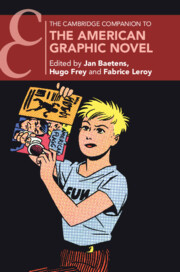Book contents
- The Cambridge Companion to the American Graphic Novel
- The Cambridge Companion to the American Graphic Novel
- Copyright page
- Contents
- Figures
- Contributors
- Editors’ Acknowledgments
- Introduction
- Part I History and Genre
- Part II Graphic Novels and the Quest for an American Diversity
- 10 Expressions of Jewishness alongside Grief in American Graphic Novels
- 11 Black Looking and Looking Black
- 12 African American New History-Writing in Graphic Narratives
- 13 Coming to America, “Land of the Free”
- 14 Spatiotemporal Projections
- 15 Queer Graphic Novels
- 16 American Women’s Lives in Graphic Novels
- Index
- Cambridge Companions To …
- References
15 - Queer Graphic Novels
A Paradigm of Paradox
from Part II - Graphic Novels and the Quest for an American Diversity
Published online by Cambridge University Press: 10 January 2024
- The Cambridge Companion to the American Graphic Novel
- The Cambridge Companion to the American Graphic Novel
- Copyright page
- Contents
- Figures
- Contributors
- Editors’ Acknowledgments
- Introduction
- Part I History and Genre
- Part II Graphic Novels and the Quest for an American Diversity
- 10 Expressions of Jewishness alongside Grief in American Graphic Novels
- 11 Black Looking and Looking Black
- 12 African American New History-Writing in Graphic Narratives
- 13 Coming to America, “Land of the Free”
- 14 Spatiotemporal Projections
- 15 Queer Graphic Novels
- 16 American Women’s Lives in Graphic Novels
- Index
- Cambridge Companions To …
- References
Summary
This chapter studies the expression of queerness, gender and sexual identity, and diversity in comics and graphic novels. It identifies several stages in the history of the medium, from earlier coded or implicit representations of queer identities designed to circumvent the Comics Code Authority to increasingly and openly acknowledged visualizations of non-heteronormative subject matters in contemporary works. The chapter offers close readings of various coming-out narratives that use the graphic memoir form as a space for self-excavation and self-disclosure, drawing connections with a wider social of familial context (Howard Cruse, David Wojnarowicz, and especially Alison Bechdel, whose Fun Home catapulted queer graphic novels into the mainstream). It also contrasts the “normalization” approach of mainstream publishers, who focus on diversity and support equality by featuring queer characters in ensemble casts, albeit at the risk of presenting a superficial image of queerness, and the more exclusive focus of alternative publishers and individually produced comics-zines, more centered on personal experiences.
Keywords
- Type
- Chapter
- Information
- The Cambridge Companion to the American Graphic Novel , pp. 256 - 271Publisher: Cambridge University PressPrint publication year: 2023

